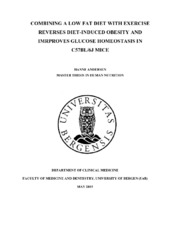| dc.description.abstract | Background: The prevalence of obesity and obesity- related disorders, including type 2 diabetes and non-alcohol fatty liver disease is alarmingly high. These conditions can mostly be attributed to increased intake of energy dense food and decreased physical activity. It is also proposed that the obesogenic effect of a unfortunate diet is influenced by protein source. There is disagreement in defining the best way to deflect the obesity trend; however, most people agree that dietary changes and/or exercise are crucial in the treatment of obesity and its related disorders. Whether it is the effect of exercise or diet that is essential, is highly debated. Furthermore, little is known about the impact of various protein sources in terms of weight loss. Methods: Male C57BL/6J BomTac mice were fed a high fat - high sucrose diet with casein, salmon and entrecôte for seven weeks to promote obesity. Weight loss was induced by changing to either a low fat diet with salmon or entrecôte, exercise with continuous high fat - high sucrose feeding or with a combination of a low fat diet and exercise. We evaluated the effect of exercise and a low fat diet with different protein sources on weight loss, body composition, glucose homeostasis and hepatic gene expression. Body composition was determined by MRI scan prior to, in the middle and at the end of the experiment. Glucose tolerance test and insulin tolerance test were performed to evaluate glucose homeostasis and insulin sensitivity. Real time qPCR was conducted to analyze relative gene expression in terms of fat accumulation and fatty acid oxidation in the liver. Results: Obesity was induced and insulin sensitivity was impaired when 2/3 of casein was replaced with salmon and entrecôte in a high fat - high sucrose diet. Exercise was not of significance in terms of weight loss in mice fed high fat - high sucrose diet, but a low fat diet reduced body weight and exercise decreased it further. A low fat diet and exercise intervention for 5 weeks decreased fat mass and increased lean mass. Glucose tolerance and insulin sensitivity were improved by low fat diet and the combined treatment of low fat diet and exercise. Mice fed low fat diet with salmon had generally a higher expression of genes involved in fatty acid oxidation and lower expression of genes involved in fat accumulation compared to the mice fed a low fat diet with entrecôte. Conclusion: A mixture of meat, fish and casein proteins promote obesity compared to proteins solely from casein. A low fat diet combined with exercise has beneficial effects in terms of weight loss, body composition and insulin sensitivity. Low fat diet alone improve plasma glucose levels and expression of genes involved in fat accumulation and fatty acid oxidation. The importance of protein source in a low fat diet seem insignificant with the exception of relative gene expression in the liver, where mice fed salmon exerts beneficial effects. | en_US |
